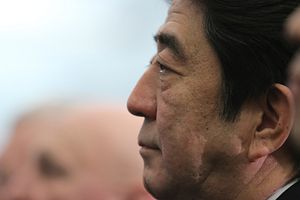Reports of the Trans-Pacific Partnership’s (TPP) death have been greatly exaggerated. At least as far as Japan is concerned.
To be sure, Trump’s decision to withdraw the United States from the agreement is a major blow to the agreement and specifically to Prime Minister Shinzo Abe’s plans for TPP. Abe’s comment that TPP would be “meaningless” without the United States wasn’t a comment that Japan was giving up on TPP as some have asserted, it only meant to emphasize Japan’s view of the importance of U.S. participation.
Abe will likely try to convince the Trump administration to reenter the agreement, and given that Wilbur Ross, Trump’s designate for Commerce Secretary and presumed lead on trade issues, has supported TPP in the past (along with other cabinet nominees), it may not be the worst idea to sound out the incoming administration on the possibility and explore the conditions under which that would happen. For their part, Japanese policymakers say they are planning to continue to pursue TPP, either with the United States or among the remaining 11 members.
Japan will simultaneously continue to pursue RCEP, but the idea that RCEP represents a vote for Chinese economic governance is largely Washington-driven. Asia itself rejects the idea that it should have to choose between the United States and China. Participation in RCEP should not be seen as acquiescing to a China-led future—RCEP is originally an ASEAN initiative.
The issue with RCEP isn’t China’s participation; it’s the fact that the agreement’s provisions are weak in areas where TPP’s were strong. TPP’s real ambition, and what made it such an innovation, was in its rules which covered sectors that had never been addressed previously in trade agreements. Granted, China’s participation is largely the reason why RCEP’s rules aren’t as robust as TPP’s given the relevance of state-owned enterprises to China’s economy as well as other areas, like intellectual property, where China’s rules still lag well behind. But it’s better to think of RCEP as a stepping stone to TPP or for a future free trade area of the Pacific than a zero-sum win for China.
For Japan, participation in RCEP is a “next best” option and needs to be considered in the context of Japan’s larger international engagement on economic deal-making, such as with the Japan-EU Free Trade Agreement. Indeed, at the very moment when most of the world seems to be retreating from international economic engagement, Japan seems to have every intention to move forward.
What about the United States? While many of Trump’s cabinet appointees have expressed support for TPP in the past, Trump’s promise to withdraw the United States from TPP “on day one” along with the bludgeoning the agreement took in the presidential campaign rules out U.S. participation for the immediate future. Instead, a bilateral Japan-U.S. free trade agreement is probably more likely and more consistent with the Trump administration’s deal-making characteristics.
Pursuing this option would be undoubtedly frustrating for the Japanese negotiators, bureaucrats, and politicians, who spent years discussing ascension, negotiating the terms, and expending political capital to achieve ratification. It would force them to work with a U.S. administration that would be markedly different than its predecessors. It is also not yet clear what Japan would have to concede in order to reach an agreement with the Trump administration, but they would almost certainly make demands on the sensitive issue of currency manipulation.
But securing a bilateral agreement between the United States and Japan may be the best outcome in the short- to medium-term. It would achieve the long-coveted goal of a free trade agreement between the United States and Japan, provide a degree of assurance that the United States is committed to the economic future of East Asia, and, if the bilateral conforms sufficiently to TPP standards, would serve as a platform for future U.S. participation in TPP if the United States ultimately chooses to do so. And it would also fit with the larger context of the Abe administration’s pursuit of increasing regional economic cooperation.
For a country whose foreign policy was often derided for its deference to gaiatsu (outside pressure), the idea that a Japanese prime minister would take the initiative not only in reaching out to an insurgent president-elect like Donald Trump, but also in helping to deepen liberal economic engagement, is something that should be welcomed. It will not be easy, but it is worth trying. Advocates of the liberal order have seen their allies steadily dwindle. They may have one in Prime Minister Abe if he is able to take the opportunity to lead.
Paul Nadeau is an independent writer based in Tokyo, Japan.

































